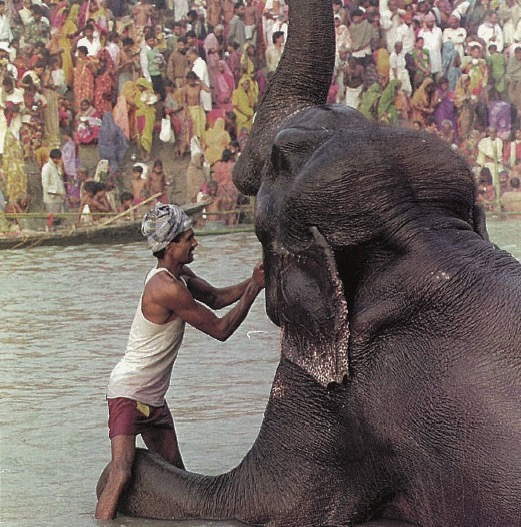By Hema Shukla, Associated Press
Under the shade of a mango grove in eastern India, four men leisurely haggle over the price of a magnificent ten-foot-tall elephant. “At least 1 million rupees,” owner Ram Lakhan Verma says, demanding the equivalent of US$25,500 for 25-year-old Bhola. “Look at his tusks. Look at his nails. He is a healthy male in his prime.” “Too much, too much,” wrangles the prospective buyer, unimpressed by the long tusks covered with brass rings or Bhola’s leathery body painted in vivid colors. The deal falls through.
No problem: there are dozens of other elephants to choose from. More than 100 gaily decorated elephants quietly chew on sugarcane and rice paddy along the Ganges River while their owners wait for buyers at Asia’s oldest and largest elephant fair, a yearly month-long jamboree during November. The elephants come from across India to Sonepur, a dusty village in the eastern state of Bihar that has hosted the annual fair for at least 300 years. Hindu mythology tales describe a fierce battle between a divine elephant and a vicious crocodile that is won by the elephant. Some people claim the battle took place in Sonepur.
Hundreds of thousands of people throng the fair on the first day to buy and sell elephants, horses, cows, buffaloes, goats, dogs and birds. Some have come just to have a good time. Crowds mill about the elephants–the star attraction–gawking at the brass rings on their tusks and ears and the bright designs painted on their bodies.
Elephant owner Verma walked 10 days with a retinue of 50 people and five elephants to reach the fair. The trek from his village of Faizabad, 180 miles to the west, was arduous, but Verma says nowhere else can he find such a market for his prized pachyderms. As dusk falls, Verma still had not sold Bhola. But he bought an eight-year-old baby elephant for US$12,300. In a few years, he hopes to sell it for a good profit.
The deals are almost always in cash to avoid bad checks. And Verma, like most dealers, is surrounded by burly bodyguards with fierce mustaches and guns. The number of elephants available for sale has dwindled over the years, Verma says. The Indian government has banned capture of wild elephants, to help animal conservation. But elephants still are sought by loggers, who use them in forests to haul trees, since machines often cannot maneuver through the vegetation.
Wealthy Hindu temples use elephants during religious ceremonies, often to carry idols of the Gods through the streets. Others hire out the animals for weddings and festivals. Though many people own elephants as an investment–earning good profits off the sale of a full-grown animal–the prime reason for having elephants is social status.
Elephants are a status symbol among wealthy land owners, especially in rural India. The rich have vast farm fields and orchards that can satisfy the voracious appetite of these mammals, which are completely vegetarian. An adult elephant eats 450 pounds of sugarcane, rice paddy and grass a day–one-fifth its body weight. Feeding the massive mammal costs about US$500 a month, about one year’s wages for a farm hand. But owners can make up the money just using the dung as fertilizer for their farms. “The rich love to have elephants tied to their front door. It is a throw back to the days of the maharajas, when a man was respected by the number of elephants he had,” says Sukhiya, a villager at the fair.
